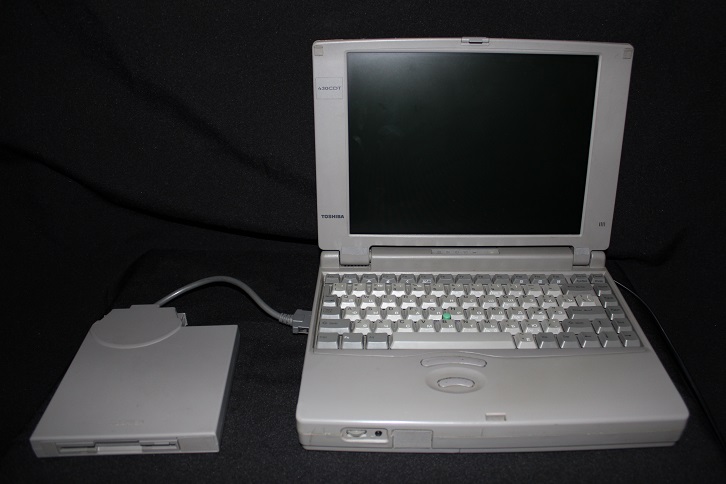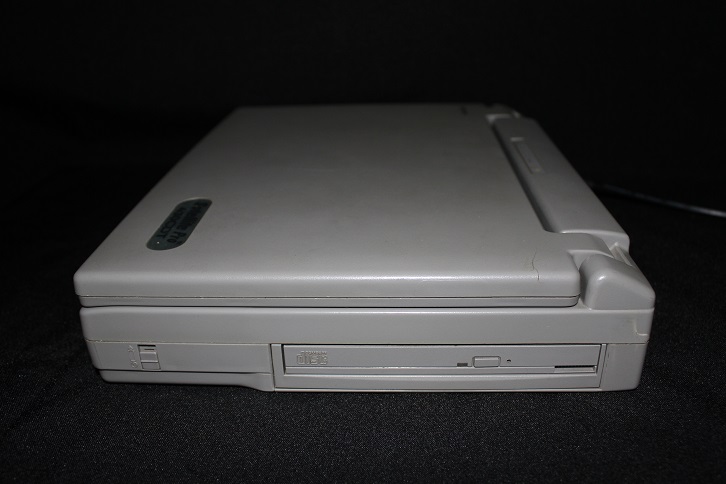Rare Toshiba Satellite Pro 430CDT Laptop
Surely, some of you, at home or at work, have some ancient mammoth with a Pentium II processor or lower, designed for those tasks that a modern computer cannot do. In my case, this is a Toshiba Satellite Pro 430CDT laptop, with which many UPSs were calibrated and more than one piece of iron was reflashed. Yes, and floppy disks on it can be read and formatted, and this is sometimes required during the next experiment on an ancient computer that fell into my hands.

Those who are interested, you are welcome under the cat.
Toshiba Satellite Pro 430CDT specifications:
')
Processor: Intel Pentium 120 MHz
RAM: 32 MB (initially - 16 MB)
Hard disk: 7.8 GB (not native)
Screen: 11.3 "TFT (800x600x24 bit) SVGA, active matrix.
External monitor: Maximum resolution 1024x768x16 bit
Ports: LPT, COM, PS / 2 for mouse or keyboard, external monitor port, infrared port
PCMCIA: 2 typeII / I ports or one typeIII.
Sound Card: ESS 688 and Yamaha OPL3 (YMF262)
Video Card: Chips & Tech HIQV32 (CT65550) 2Mb
FDD: 3.5 "1.44MB interchangeable with CD, or external on a cord
CD-ROM: is (10x), interchangeable with FDD
Mouse Pointer: Trackpoint (Accupoint)
Dimensions: 299 x 235 x 55.8 mm, weight 3.35 kg with battery
Battery: Li-Ion 10.8V 3600mAh

The laptop, along with a spare battery and external FDD drives, fit into a small case.

On the front side of the notebook is a speaker, volume control and headphone jack.

On the right is a latch that secures the battery cover and the compartment in which the CD-ROM is located. Instead of a CD-ROM drive, you can insert a 3.5 "drive into this bay.

At the back there is an infrared port, a VGA, LPT connector, a docking connector (closed by curtains), a fan, and a PS \ 2 port.

On the left, on the notebook, there is a COM port, a connector for connecting an external CD-ROM or FDD compartment, two PCMCIA typeII / I slots, in which you can also insert one typeIII card. And of course there is a power button and two audio jacks for microphone and headphones.

CD-ROM is easily removed from the compartment with a special lever on the bottom of the case.

In the vacant internal compartment, you can insert a floppy disk drive, taken out of the external compartment.

This is the external drive bay for CD-ROM \ FDD drives.

And so it connects to a laptop.

The battery cover is removed. Next - a spare battery. Each battery holds about an hour.

Green Accupoint (such a replacement mouse,our response to Chamberlain ), hiding among the keyboard buttons.
And now let's disassemble it? Let's!

Remove the keyboard.

Two green rechargeable batteries. One of them died - the current time and date is saved, but the clock of the laptop is turned off.

Bottom view. Battery compartment and an additional 16 MB memory module. In the middle - a lever to push the CD-ROM.

Caution high voltage.

Under the gray heatsink with a pimple is the processor. We'll have to believe the word, since I could not remove the radiator.

Audio card.

IR port.

Video card position 1.

Video card position 2.

HDD.
This is where the insides of the laptop come to an end. Now you need to collect it and turn it on.

We plug in the PCMCIA Ethernet card and turn on the laptop.

Hurrra! Earned!

Reboot. Check the BIOS settings, everything seems OK.

Windows 98.

Yes, only 32 MB of RAM.

And the processor is not particularly fast.

But Total Commander is starting ...

And Winamp too ... True it slows down, if you move the window, but you can listen to music.

And even on the Internet you can sit. But not for long ...

Then you need to write something in Word 97.

And finally calibrate the UPS.

Mission Complete! Shutdown now!

Those who are interested, you are welcome under the cat.
Toshiba Satellite Pro 430CDT specifications:
')
Processor: Intel Pentium 120 MHz
RAM: 32 MB (initially - 16 MB)
Hard disk: 7.8 GB (not native)
Screen: 11.3 "TFT (800x600x24 bit) SVGA, active matrix.
External monitor: Maximum resolution 1024x768x16 bit
Ports: LPT, COM, PS / 2 for mouse or keyboard, external monitor port, infrared port
PCMCIA: 2 typeII / I ports or one typeIII.
Sound Card: ESS 688 and Yamaha OPL3 (YMF262)
Video Card: Chips & Tech HIQV32 (CT65550) 2Mb
FDD: 3.5 "1.44MB interchangeable with CD, or external on a cord
CD-ROM: is (10x), interchangeable with FDD
Mouse Pointer: Trackpoint (Accupoint)
Dimensions: 299 x 235 x 55.8 mm, weight 3.35 kg with battery
Battery: Li-Ion 10.8V 3600mAh

The laptop, along with a spare battery and external FDD drives, fit into a small case.

On the front side of the notebook is a speaker, volume control and headphone jack.

On the right is a latch that secures the battery cover and the compartment in which the CD-ROM is located. Instead of a CD-ROM drive, you can insert a 3.5 "drive into this bay.

At the back there is an infrared port, a VGA, LPT connector, a docking connector (closed by curtains), a fan, and a PS \ 2 port.

On the left, on the notebook, there is a COM port, a connector for connecting an external CD-ROM or FDD compartment, two PCMCIA typeII / I slots, in which you can also insert one typeIII card. And of course there is a power button and two audio jacks for microphone and headphones.

CD-ROM is easily removed from the compartment with a special lever on the bottom of the case.

In the vacant internal compartment, you can insert a floppy disk drive, taken out of the external compartment.

This is the external drive bay for CD-ROM \ FDD drives.

And so it connects to a laptop.

The battery cover is removed. Next - a spare battery. Each battery holds about an hour.

Green Accupoint (such a replacement mouse,
And now let's disassemble it? Let's!

Remove the keyboard.

Two green rechargeable batteries. One of them died - the current time and date is saved, but the clock of the laptop is turned off.

Bottom view. Battery compartment and an additional 16 MB memory module. In the middle - a lever to push the CD-ROM.

Caution high voltage.

Under the gray heatsink with a pimple is the processor. We'll have to believe the word, since I could not remove the radiator.

Audio card.

IR port.

Video card position 1.

Video card position 2.

HDD.
This is where the insides of the laptop come to an end. Now you need to collect it and turn it on.

We plug in the PCMCIA Ethernet card and turn on the laptop.

Hurrra! Earned!

Reboot. Check the BIOS settings, everything seems OK.

Windows 98.

Yes, only 32 MB of RAM.

And the processor is not particularly fast.

But Total Commander is starting ...

And Winamp too ... True it slows down, if you move the window, but you can listen to music.

And even on the Internet you can sit. But not for long ...

Then you need to write something in Word 97.

And finally calibrate the UPS.

Mission Complete! Shutdown now!
Source: https://habr.com/ru/post/165027/
All Articles